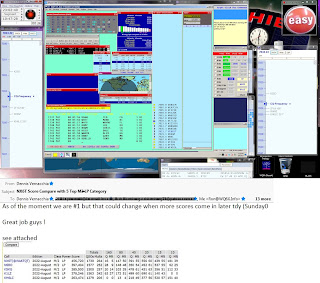Operating the RSGB IOTA Islands on the Air) contest is always a confusedly-weird operation,
bringing up mixed feelings for me. The IOTA GiG is loaded w/possibilities, yet often leaves
me disappointingly frustrated. I have written about this GiG many times before:
- [X] - RSGB IOTA - Blast from the past
- [X] - 2021 RSGB IOTA Contest
- [X] - 2020 RSGB IOTA Contest
- [X] - 2017 RSGB IOTA Contest
Overall, I like the premise behind the IOTA event, which is to radio-activate islands around the world,
which are differentiated by a unique numbering system. All of this is explained on the RSGB Website ([CLICK HERE] to see the rules.)
The 2022 GiG was simply a repeat of the spirit of former IOTA GiGs. Evidently, this weekend tied
in with some equipment cabling updates at the So. California (Anza) station, requiring us to keep
an eye on low-band SWR signatures.
With no notice that a remote operation was imminent, I began things in Concord as WQ6X. With barely 2 QSOs in the log, a text from N6KI informed me that NX6T could run a Multi-2 operation, beginning at 20:00z, giving us 16 hours to work the NX6T "magic". During my dinner break, WQ6X managed a few more QSOs in the log - just to say that I was there.
Because the IOTA GiG runs well with WINTEST, I set up both stations at the WA6TQT site (in Anza) to run as a Multi-2 operation, with WQ6X running STN-1 and N6KI running on STN-2. For the IOTA GiG, 160 meters is not allowed and 10-meters was a virtual no-show, leaving 80 thru 15 meters to make it all happen. 15-meters signals were rather sparse making 20-meters (and later 40-meters)
for most of the operation.
We experienced quite reasonable Southern California openings to Europe in this event. With the Solar Flux Index (SFI) down to 91+ for the weekend, I am left wondering what conditions to EU would have been like with an SFI of 170+ (as we had 10 days earlier). Being mid-summer time, the usual high summer-time noise-levels made signal-copy quite difficult. Attempting ssb communication amidst all that noise would've been a DISASTER - running Cw was the only way.
When I came on shift at 09:00z Sunday morning, the goal was to work everyone while focusing
on 40/80 meter Asian stations. Because there are no NCDXF beacons on 40-meters, I rely on the
Russian military beacons for signal-level checks. The Vladivostok ("
F") beacon has been off-air for several months. The fickle "
K" beacon has again changed its transmission to "
K K" from last week's "
K K K" identification. Kamchatka was LOUD in BOTH Anza and Concord. The "
M" beacon (Magadan) was also present, altho comparatively, not nearly as loud.
JA stations are often plentiful in most DX-style contests. Because they represent 3 "islands" (AS-007, AS-077, AS-078), 15-point QSOs just "across the pond" was an exciting prospect. Unfortunately, the JA participation was poor this year, despite solid propagation paths to East Asia. A couple of lengthy "CQ IOTA" calls on 3522.22 added a WHOPPING 2 QSOs to the log; at least both were island multipliers.
For me, this contest was mainly an exercise in testing antenna SWR in Anza. It also afforded the opportunity for testing the recently-added AP-411 audio-delay unit along with remote radio operation. Overall,the external JPS NIR filters on the receiving end seem more effective than the filters built-in to the remote K3 radios. Stereo Cw with remote operations work just as well as with the local Yaesu FT-2000.
When it was all over, we learned that while the contest rules don't specifically state it, multi-OP operations are for Island Stations Only. Attempting to submit a log, there was no multi-OP option
for "WORLD" stations. In the end, all of our work will result in a CHECKLOG.
DiD YOU work the RSGB Islands on the Air contest?
How many islands did YOU Snag?
Is NX6T or WQ6X in YOUR LoG?

















